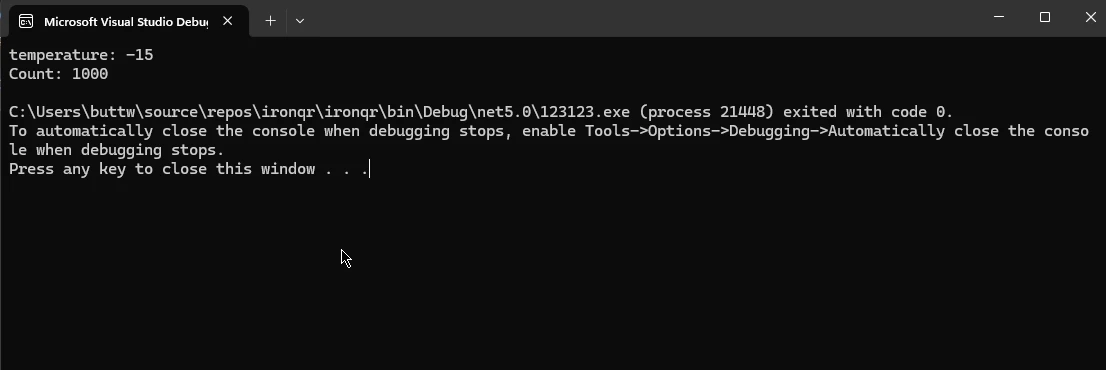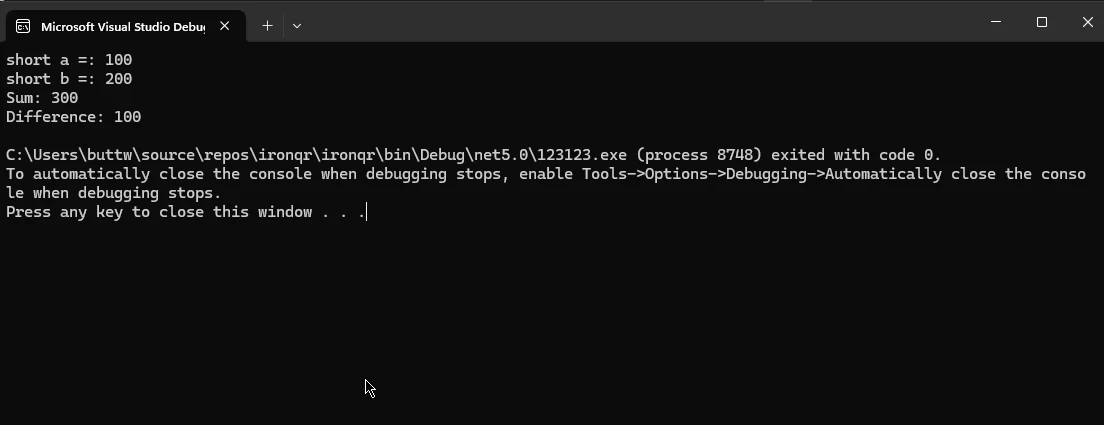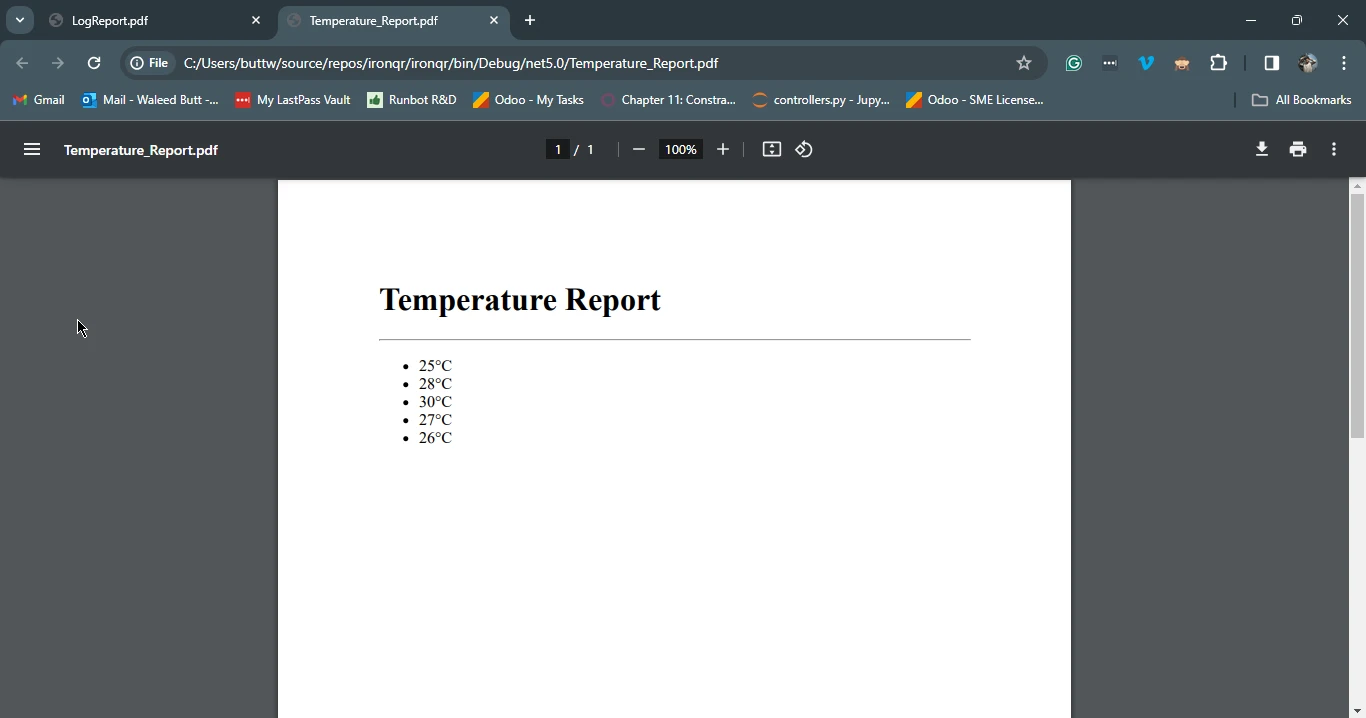Published April 4, 2024
C# Short (How It Works For Developers)
In C#, the short data type is one of the C# data types and is used to represent integer values within a limited range. Despite its smaller size compared to int value or long value types, short can be beneficial in scenarios where memory efficiency or specific value range requirements are essential. It can hold numeric types of both positive values and negative values and can be easily converted to other data types. This guide delves into the intricacies of the C# short, covering its characteristics, usage scenarios, common operations, and best practices. Additionally, we'll explore examples showcasing the versatility of short keyword in various programming contexts.
We'll explore the fundamental concepts of IronPDF and demonstrate its versatility through a practical example leveraging the short data type in C# to create and convert a PDF file.
1. Exploring the Significance of short .NET type
Before delving into technical details, let's grasp the significance of the short data type in C#.
1.1. Memory Efficiency
The short data type occupies a maximum of only 16 bits (2 bytes) of memory, making it more memory-efficient than int type (32 bits) or long (64 bits). In memory-constrained environments or when dealing with large datasets, utilizing short user input can lead to significant memory savings.
1.2. Range Limitations
Being a 16-bit signed integer, short has a limited range compared to int or long. It can represent integer minimum and maximum values from -32,768 to 32,767 inclusive. Despite its range limitations, short is suitable for scenarios where the magnitude of values falls within its range.
2. Practical Usage Scenarios
2.1. Storage Optimization
When designing data structures or algorithms that operate on a large and variable number of integer values within the short range, by declaring type short variables can conserve memory and improve performance.
2.2. Interoperability
In scenarios involving Interop with external systems or libraries that expect 16-bit integer values, such as certain hardware devices or legacy systems, short provides seamless compatibility.
2.3. Signal Processing
In signal processing applications or numerical computations where memory efficiency and computational speed are crucial, short can be preferred for storing waveform data, sensor readings, or audio samples.
3. Working with short in C#
3.1. Declaration and Initialization
short temperature = -15; //default value
short count = 1000;short temperature = -15; //default value
short count = 1000;Dim temperature As Short = -15 'default value
Dim count As Short = 1000Output

3.2. Arithmetic Operations
short a = 100;
short b = 200;
short sum = (short)(a + b); // Ensure explicit casting for arithmetic operations involving `short`.
short difference = (short)(b - a);short a = 100;
short b = 200;
short sum = (short)(a + b); // Ensure explicit casting for arithmetic operations involving `short`.
short difference = (short)(b - a);Dim a As Short = 100
Dim b As Short = 200
Dim sum As Short = CShort(a + b) ' Ensure explicit casting for arithmetic operations involving `short`.
Dim difference As Short = CShort(b - a)Output

3.3. Comparison and Logical Operations
short x = 10;
short y = 20;
bool isEqual = (x == y);
bool isGreater = (x > y);
bool logicalResult = (x != y) && (x < 100);short x = 10;
short y = 20;
bool isEqual = (x == y);
bool isGreater = (x > y);
bool logicalResult = (x != y) && (x < 100);Dim x As Short = 10
Dim y As Short = 20
Dim isEqual As Boolean = (x = y)
Dim isGreater As Boolean = (x > y)
Dim logicalResult As Boolean = (x <> y) AndAlso (x < 100)Output

3.4. Arrays and Collections
short[] temperatures = new short[] { -10, 0, 10, 20, 30 };
List<short> scores = new List<short>() { 90, 85, 95, 88 };short[] temperatures = new short[] { -10, 0, 10, 20, 30 };
List<short> scores = new List<short>() { 90, 85, 95, 88 };Dim temperatures() As Short = { -10, 0, 10, 20, 30 }
Dim scores As New List(Of Short)() From {90, 85, 95, 88}Output

4. Best Practices for short Usage
4.1. Understand Range Limitations
Be mindful of the range limitations of short (-32,768 to 32,767) and ensure that the values being assigned, implicitly converted, or computed fall within this minimum and maximum values range.
4.2. Avoid Unnecessary Casting
While arithmetic operations involving short may require explicit casting, avoid excessive casting to maintain code readability and reduce complexity.
4.3. Document Intent
Provide clear documentation or comments when using short to indicate its purpose, especially in scenarios such as the above example, where its usage might not be immediately obvious.
5. Introducing IronPDF
IronPDF stands as a cornerstone solution in the realm of C# development, offering developers a powerful toolkit for seamlessly generating, editing, and manipulating PDF documents within their applications. With its intuitive API and extensive feature set, IronPDF empowers developers to effortlessly integrate PDF capabilities into their C# projects, unlocking a myriad of possibilities in document generation, reporting, and content distribution.
To install IronPDF in your C# application, run the following command in the NuGet Package Manager console.
Install-Package IronPdf
5.1. Harnessing the Power of C# Short with IronPDF: A Practical Example
Now, let's delve into a practical following example showcasing the integration of the short data type in C# with IronPDF for creating a PDF file. In this scenario, imagine a temperature monitoring application that collects sensor data and generates a concise report summarizing the temperature readings. We'll utilize the compactness of the short data type to represent temperature values efficiently and leverage IronPDF to dynamically compile this PDF report.
using IronPdf;
using System;
class Program
{
static void Main(string[] args)
{
// Sample temperature data represented as short integers
short[] temperatureData = { 25, 28, 30, 27, 26 };
// Generate PDF report
var pdf = new ChromePdfRenderer();
var htmlContent = "<h1>Temperature Report</h1><hr/><ul>";
foreach (var temperature in temperatureData)
{
htmlContent += $"<li>{temperature}°C</li>";
}
htmlContent += "</ul>";
var pdfOutput = pdf.RenderHtmlAsPdf(htmlContent);
// Save PDF to file
var outputPath = "Temperature_Report.pdf";
pdfOutput.SaveAs(outputPath);
Console.WriteLine($"PDF report generated successfully: {outputPath}");
}
}using IronPdf;
using System;
class Program
{
static void Main(string[] args)
{
// Sample temperature data represented as short integers
short[] temperatureData = { 25, 28, 30, 27, 26 };
// Generate PDF report
var pdf = new ChromePdfRenderer();
var htmlContent = "<h1>Temperature Report</h1><hr/><ul>";
foreach (var temperature in temperatureData)
{
htmlContent += $"<li>{temperature}°C</li>";
}
htmlContent += "</ul>";
var pdfOutput = pdf.RenderHtmlAsPdf(htmlContent);
// Save PDF to file
var outputPath = "Temperature_Report.pdf";
pdfOutput.SaveAs(outputPath);
Console.WriteLine($"PDF report generated successfully: {outputPath}");
}
}Imports IronPdf
Imports System
Friend Class Program
Shared Sub Main(ByVal args() As String)
' Sample temperature data represented as short integers
Dim temperatureData() As Short = { 25, 28, 30, 27, 26 }
' Generate PDF report
Dim pdf = New ChromePdfRenderer()
Dim htmlContent = "<h1>Temperature Report</h1><hr/><ul>"
For Each temperature In temperatureData
htmlContent &= $"<li>{temperature}°C</li>"
Next temperature
htmlContent &= "</ul>"
Dim pdfOutput = pdf.RenderHtmlAsPdf(htmlContent)
' Save PDF to file
Dim outputPath = "Temperature_Report.pdf"
pdfOutput.SaveAs(outputPath)
Console.WriteLine($"PDF report generated successfully: {outputPath}")
End Sub
End ClassThe above example with a C# code snippet demonstrates the generation of a PDF report using the IronPDF library. It begins by defining an array temperatureData containing sample temperature readings represented as short integers. Next, it dynamically generates HTML content for the PDF report, incorporating the temperature values into a structured format.
Utilizing IronPDF's ChromePdfRenderer, it then converts the HTML content into a PDF document. Finally, the generated PDF report is saved to a file named "Temperature_Report.pdf", and a success message confirming the generation is displayed in the console. Overall, this code showcases the seamless integration of C# code with IronPDF to generate visually appealing PDF reports.
Output

6. Conclusion
The short data type in C# serves as a compact yet powerful tool for handling integer values within a limited range. Its memory efficiency and range limitations make it ideal for scenarios where memory optimization and compatibility are paramount. Whether storing sensor data, optimizing storage in data structures, or interfacing with legacy systems, short offers versatility and effectiveness.
By following best practices and understanding its nuances, developers can harness the potential value of short to enhance the performance and efficiency of their C# applications. When coupled with tools like IronPDF, which streamline PDF generation, short becomes even more valuable, enabling seamless integration of data into concise and visually appealing reports.
IronPDF license starts at $749, it also offers a free trial license which is a great opportunity to get to know IronPDF functionality. To know more about IronPDF HTML to PDF conversion visit the conversion page.











